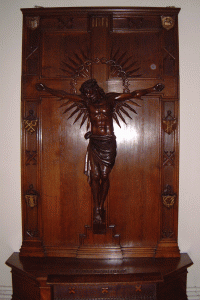A LOOK AROUND THE CHURCH
We welcome you to this look inside the Church with its magnificent stained glass windows and reredos, which we hope you will find interesting.
The Church which seats some 400 people was built during the First World War. It was refurbished in the 1960’s after a fire badly damaged the Sacristy and part of the Church. The Sanctuary was re-modelled in 1996 in accordance with the Liturgical Reforms of the Second Vatican Council.
Church highlights
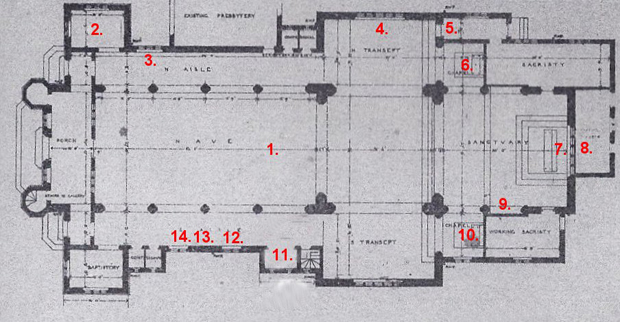
Outline plan of the Church – taken from the “Builder Magazine” December 1915.
1. Nave and Corbels
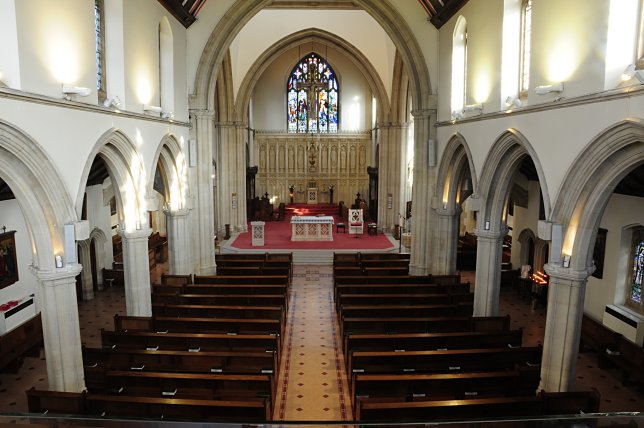
The Nave of the Church from the Organ Loft.
The nave is 27 feet 6 inches across and bordered by two processional aisles 7 feet 6 inches wide giving a total width of 46 feet 6 inches. The arches between the aisles and the nave are admirable in their proportions.
As part of the 100th Anniversary Celebrations a series of 6 Corbels were commissioned and are now in place on the main pillars of the Nave.
Looking from the Main Entrance on the left-hand side these are:
2. Calvary Chapel
Inside the wrought-iron gates on the left-hand side of the church is the CALVARY CHAPEL containing the Memorial to those killed in the First World War. There is the magnificent wooden carving of the Calvary scene on which the events of the passion have been delicately carved around the cross. The Memorial bears the inscription “In loving memory of Ronald Douglas Davidson”, and research by the Commonwealth War Graves Commission has concluded that he was a soldier killed in the First World War. Two soldiers of that name fell in the War. One in the Royal Sussex Regiment who died on 11 November 1917 aged 22 years old; the other was an Australian Infantryman who died on 16 September 1917.
3. Stained Glass Window of St Teresa, St Thomas More & St John
Next to the Calvary Chapel is the stained glass window installed in 1962 in memory of a former parishioner, in honour of 3 saints who are:
ST THERESA OF LISIEUX
ST THOMAS MORE
ST JOHN THE EVANGELIST (who is linked with the legend of St Edward).
The window as made by Goddard and Gibbs
4. Painting of the Last Supper
A painting of the Last Supper has recently been hung on the transept wall opposite the Sacred Heart Altar. It was painted in 1999 by a Spanish artist Milagros Esteban King who lives at Twickenham.
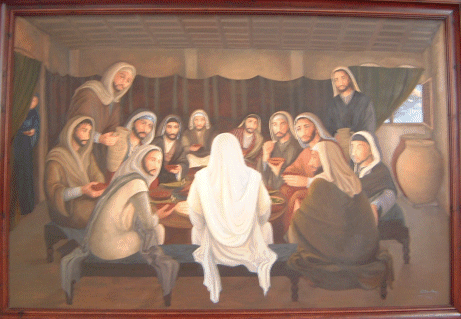
5. Stations of the Cross
Unlike most other Catholic Churches, the Stations of the Cross in St Edward’s are oil paintings. The artist is unknown. The stations were donated by former Parishioners and represents a scene from the passion and death of Christ. They are used mainly for devotional purposes during Lent.
6. Statue of St Edward the Confessor
The statue of St Edward the Confessor, carved in stone, can be seen over the entrance to the sacristy and was donated by Mrs Mortimer an early convert in the Parish.

7. Reredos
In celebration of the 25th Anniversary of the founding of the parish, December 25th 1934, ten statues of the English Saints and Beati were placed in the niches of the reredos. These were the work of Lindsay Clark in collaboration with the architect, Mr D Reid. As the Catholic Times of December 28th 1934 reported, Lindsay Clark’s work was so skilful and delicate that the statues appeared to have always been part of the whole. This combined an essential simplicity with an expressive strength; the figures have a clear characteristic solidarity which only serves to emphasise the spirituality of the ideas they embody. The saints are:- St George, St John Fisher, St Etheldreda, St Augustine of Canterbury, St William of York, St Thomas Becket, St Edmund, St Margaret Clitheroe, St Thomas More and St Alban.
The saints are: St George, St John Fisher, St Etheldreda, St Augustine of Canterbury, St William of York, St Thomas Becket, St Edmund, St Margaret Clitheroe, St Thomas More and St Alban.

8. Memorial Window
The magnificent Stained Glass Window was made by Hendra & Harper In 1947, and installed by Canon Thornton. It was the gift of the parishioners, in thanksgiving for the safe deliverance of the church, and to commemorate the heroism of a former parishioner Captain Michael who was posthumously awarded the Victoria Cross in 1943 for his heroism in the Far East. Taking its proper place as the main feature of interest in the tracery is a symbolic representation of the Crucifixion portrayed by the Lamb of God carrying the banner bearing a red cross and standing upon the Book with seven Seals (Apoc V). Surrounding the centre piece is a scroll held by Angels upon which is written the most significant exhortation concerning Sacrifice. The colour and placing of the Angels and scroll are designed to give firmness to the general lines of the whole composition.
In the main lights and lower traceries the background is formed by a light Gothic screen, reflecting the style of the reredos below and the general character of the church. This ensures that the subject matter which moves from one light to another (eg the tail of the dragon, etc) does not detract from the architectural effect of the mullions. On this background the main figure are placed in such a way as to enhance the main shape of the whole window, from the swinging of the arch particularly.
In the centre light of the window is placed the figure of St Edward the Confessor, the Patron Saint of the church, bearing his sceptre and ring. Below the figure is depicted the church which is illuminated to the front and rear by the flashes of bomb explosions demonstrating its remarkable preservation from destruction. It is to be noted that each explosion is tinged with evil, by the dragon’s claw on the one side and the wing of Lucifer on the other.
In front of the church is a portrait of Canon Charles Sims in full canonicals, commemorating his devotion to this parish.
Crowning the centre light in the lower tracery are the arms of St Edward and of Pope Pius XII. Supporting the centre light on the right is the Archangel Michael casting Lucifer from Heaven, the flaming sword in his right hand and his left pointing to his shield which bears the inscription “Quis et Deus? – Who is like to God?” On the left is St George subduing evil represented by the dragon; shown in the tracery above the figure is a shield bearing the cross of St George. Both these lights are thus concerned with action forming an effective contrast to the dignity of the centre figure of St Edward.
It is appropriate that the courage of the individual parishioners of this parish should be symbolised in these two lights by the magnificent example of Captain Michael Allmand, VC. His action is commemorated beneath St George by the badge of his regiment (6th Lancers) and below St Michael by the badge of the Ghurka regiment (showing the crossed kukri) to which he was attached when he won the Victoria Cross, the later being superimposed upon the badge.
Above the simple inscription in the outside lights are the solider saints, St Alban on the left and St Martin on the right. Above each of these in the lower traceries are their arms. The figure of St Alban by his bearing alone suggests the glorious example he set and his example is equally well suggested in the action of St Martin dividing his cloak with a beggar.
To complete the whole scheme the remaining tracery lights are filled by the flags of the Services.
A description by the late Audrey Knighton.

CAPTAIN MICHAEL ALLMAND
 Captain Michael Allmand lived in North Square in the Garden Suburb with his family. He was educated at Ampleforth College and Oxford where he studied history from 1941 until he end of 1942 when he joined the 6th Lancers Regiment of the Indian Armoured Corps. Three months later after the fall of Singapore, he was sent to India where he volunteered for the Chindits under General Wingate. He was accepted because of his character (described as gentle, dynamic, full of life with a charisma), and was attached to the 3rd Battalion of the Ghurka Regiment under “Mad Mike Calvert”.
Captain Michael Allmand lived in North Square in the Garden Suburb with his family. He was educated at Ampleforth College and Oxford where he studied history from 1941 until he end of 1942 when he joined the 6th Lancers Regiment of the Indian Armoured Corps. Three months later after the fall of Singapore, he was sent to India where he volunteered for the Chindits under General Wingate. He was accepted because of his character (described as gentle, dynamic, full of life with a charisma), and was attached to the 3rd Battalion of the Ghurka Regiment under “Mad Mike Calvert”.
Captain Allmand (then 20 years old) was commanding the leading platoon in Burma on 11 June 1944 when he was ordered to attack the Pin Hmi Road Bridge. His men were forced to take cover from fire directed from Japanese positions along the road-bank and in the surrounding jungle. He dashed on alone, killing three of the enemy with grenades and his kukri – opening the way for advance, which resulted in the capture of the bridge. The Captain inspired his men again by similar behaviour two days later, and on 23 June he led them in the final assault on the Mogaung Railway Bridge. Though suffering from the intensely painful affliction of trench-foot, so that walking was difficult, he worked his way forward to deal with a machine-gun post – and fell mortally wounded. The Victoria Cross was presented to his family by King George VI and is now in the Ghurka Museum.
9. Fatima Window
The Fatima Window depicts the apparition of Our Lady to the three children near Fatima, in Portugal in 1917. The window was installed in 1935 and was donated by parishioners.

10. Lady Altar
The Lady Altar was was a gift by the Children of Mary in 1925 On the Lady Altar is the statue of the Blessed Virgin Mary, with a painted reredos depicting (left) the story of the Annunciation when the Angel Gabriel appearing to Mary, and (right) the Visitation when Mary visited the Cousin Elizabeth. On either side of the altar are the statues of St. Anne and St. Joachim the parents of Mary.
11. Shrine of St Edward
St Edwards Shrine was was dedicated in 1996. The magnificent wood carving by Siegfrid Pietsch of Redbourne, Hertfordshire shows St Edward giving his ring to a beggar who asked for alms.
A more complete history of the Shrine is set out in the Life of St Edward
The Shrine also contains a board listing all the Parish Priests and a former Deacon.
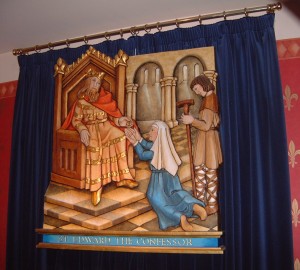
12. Stained Glass Window of St Brigid and St Patrick
Next to this is a stained glass window in honour of two Irish Saints:- ” St Bridget and St Patrick. The window made by Goddard and Gibbs was installed in 1935 in memory of the Duggan and Quinn families.
13. Plaque to Fr Bendon
On the wall next to this window is a Memorial Plaque in memory of Fr William Bendon the first Parish Priest who died in 1918 and is buried outside the Church. The reredos and the high altar were given in his memory.

Photograph showing Bishop Stack blessing a wreath at Cenenary Midninght Mass 2009
14. Stained Glass Window of St Louis and St Joseph
The last window is dedicated to the memory of Fr Louis Joseph Hemy who was an assistant Priest in the Parish and who died in the great influenza outbreak of 1918.








